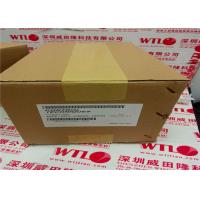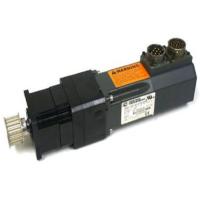Yaskawa Industrial Electric Servo Motor 2900w 1500rpm 18.5nm
SGMGH-30A2A-YR35
Configuration:
Model SGMGH-30A2A-YR35
Product Type AC Servo Motor
Rated Output 200w
Rated Torque18.6 Nm
Rated Speed 1500RPM
Power Supply Voltage 200vAC
Rated Current 23.8Amps
Features
6 Different Designs
Automatic Motor Recognition by Servo Drive
Peak Torque 300% of Nominal During 3 Seconds
Description
The Yaskawa Sigma-II Rotary Servo Motors series has 6 different
designs to provide a complete range of servo motors to meet the
power, speed and performance required per each application. The
Sigma-II has a peak torque 300% of nominal during 3 seconds and
automatic motor recognition by servo drive.
Product Family: SGMAH, SGMPH, SGMGH, SGMSH, SGMUH, SGMBH
Important Notice: Please note that any additional items included with this
equipment such as accessories, manuals, cables, calibration data,
software, etc. are specifically listed in the above stock item
description and/or displayed in the photos of the equipment. Please
contact one of our Customer Support Specialists if you have any
questions about what is included with this equipment or if you
require any additional information.
Lifecyle Active
EU RoHS Unknown
EU RoHS Version 2002/95/EC
Description
ROTARY SERVO MOTORS FOR MOTION CONTROL. FAST RESPONSE, HIGH SPEED,
AND HIGH ACCURACY
Taxonomy Electromechanical > Motors and Drives > Servo Motors
Introduction Date2006-05-30 00:00:00 ECCN EAR99
Supplier Cage Code SDM04 MSL N/R
Maximum Reflow Temperature (°C)N/R
Reflow Solder Time (Sec) N/R
Maximum Wave Temperature (°C) N/R
Wave Solder Time (Sec) N/R
Lead Finish(Plating) N/R
Under Plating Material N/R
Terminal Base Material N/R
OTHER SUPERIOR PRODUCTS
Yasakawa Motor, Driver SG- Mitsubishi Motor HC-,HA-
Westinghouse Modules 1C-,5X- Emerson VE-,KJ-
Honeywell TC-,TK- Fanuc motor A0-
Rosemount transmitter 3051- Yokogawa transmitter EJA-
Contact person: Anna
E-mail: wisdomlongkeji@163.com
Cellphone: +0086-13534205279
Similar Products
| SGMGH-03ACB61 |
| SGMGH-03ACB6C |
| SGMGH-05A2A2B |
| SGMGH-05A2A61 |
| SGMGH-05A2ASC61 |
| SGMGH-05ACA61 +SGDM-05ADA |
| SGMGH-05ACA6C |
| SGMGH-05ACC21 |
| SGMGH-09A2A21 |
| SGMGH-09ACA21 |
| SGMGH-09ACA2B |
| SGMGH-09ACA2C |
| SGMGH-09ACA61 |
| SGMGH-09ACA6B |
| SGMGH-09ACA6C |
| SGMGH-09ACB61 |
| SGMGH-09ACB6B |
| SGMGH-09PCA-AM14 |
| SGMGH-12A2B2 |
| SGMGH-12A2B21 |
| SGMGH-13A2A-YR13 |
| SGMGH-13A2A-YR23 |
| SGMGH-13A2A-YR23A |
| SGMGH-13A2A-YR24 |
| SGMGH-13ACA |
| SGMGH-13ACA21 |
| SGMGH-13ACA61 |
| SGMGH-13ACA6C |
| SGMGH-13DCA61 |
| SGMGH-1AACA61 |
| SGMGH-1EACA61 |
| SGMGH-20A2B2C |
| SGMGH-20ABA6C |
| SGMGH-20ACA61 |
| SGMGH-20ACA6B |
| SGMGH-20ACA6C |
| SGMGH-20ACB2C |
| SGMGH-20ACB61 |
| SGMGH-20D2A21 |
An advantage of using the current-based load estimation technique
is that NEMA MG1-12.47 allows a tolerance of only 10% when
reporting nameplate full-load current. In addition, motor terminal
voltages only affect current to the first power, while slip varies
with the square of the voltage.
While the voltage-compensated slip method is attractive for its
simplicity, its precision should not be overestimated.
The slip method is generally not recommended for determining motor
loads in the field.
Determining Motor Efficiency
The NEMA definition of energy efficiency is the ratio of its useful
power output to its total power input and is
usually expressed in percentage, as shown in Equation 7
The transfer line and the assembly line have had a powerful impact
in automating our factories, especially
during the middle decades of the 20th century. Their primary goal
was reduction of labor content with the financial justification
labeled as economy of scale. With labor now less than 10 percent of
the cost of manufactured goods in this country and total employment
in manufacturing less than 15 percent of the
labor force, something more is needed. What is required is motion
control and automation that is more flexible and offers other
advantages besides mass production. Some desirable advantages
include:
producing parts near the point of use, producing any of a family of
parts based on customer needs, keeping finished inventory
minimized, and responding quickly to customer requests.

These economy of scope installations typically cost 40 to 50
percent more than their predecessors because of the high degree of
flexibility that must be built in - often through motion control.
The earlier transfer and assembly lines used limit switches to turn
motors ON and OFF at fixed positions for the single part for which
it was designed. When a family of parts was involved, the
dimensions needed to be changed each time a different part came
along. This has lead to the use of continuous feedback rather than
limit switches; and servo motors and controllers rather than
induction motors with ON/OFF contactors. An indication of this
trend can be seen in the fact that the motion control segment of
the numerical machine control market is growing at about 30 percent
compared to the total market which is growing at only 20 percent.
MORE INFORMATION
DELIVERY
Logistic partners UPS, FedEx and DHL
International delivery available
Premium nine hour delivery service available to anywhere in Europe
Same day dispatch from group stock
WARRANTY
All parts new or reconditioned are covered by EU Automation 12
month warranty
RETURNS
No hassle returns policy
Dedicated customer support team
PAYMENT
Trade credit
We understand that credit is a necessary part of business and offer
credit agreements on request, subject to status.
Payment options
We accept Bank transfers and the following methods of payment:
TT , West Union ,Paypal


















